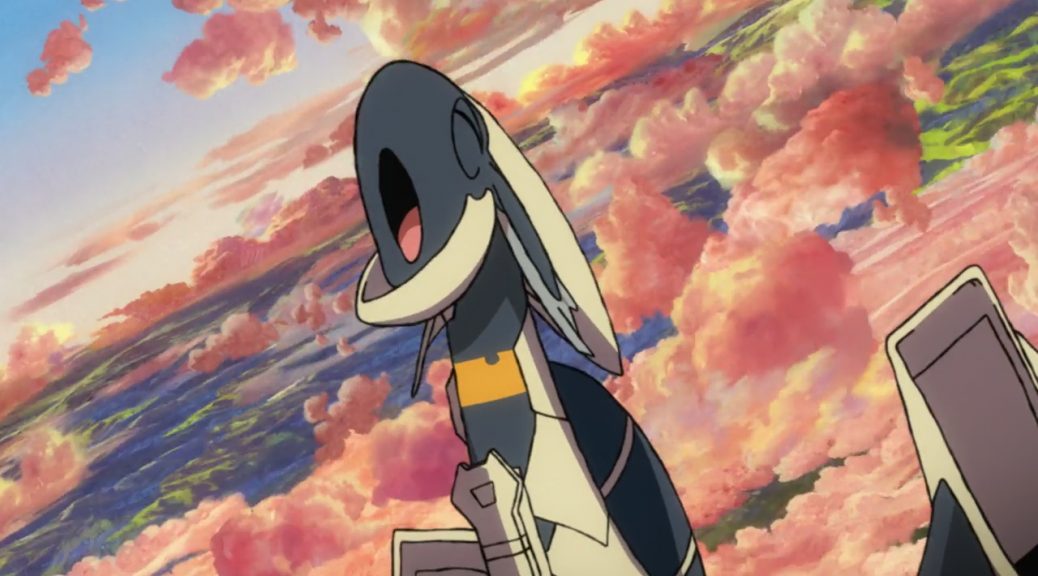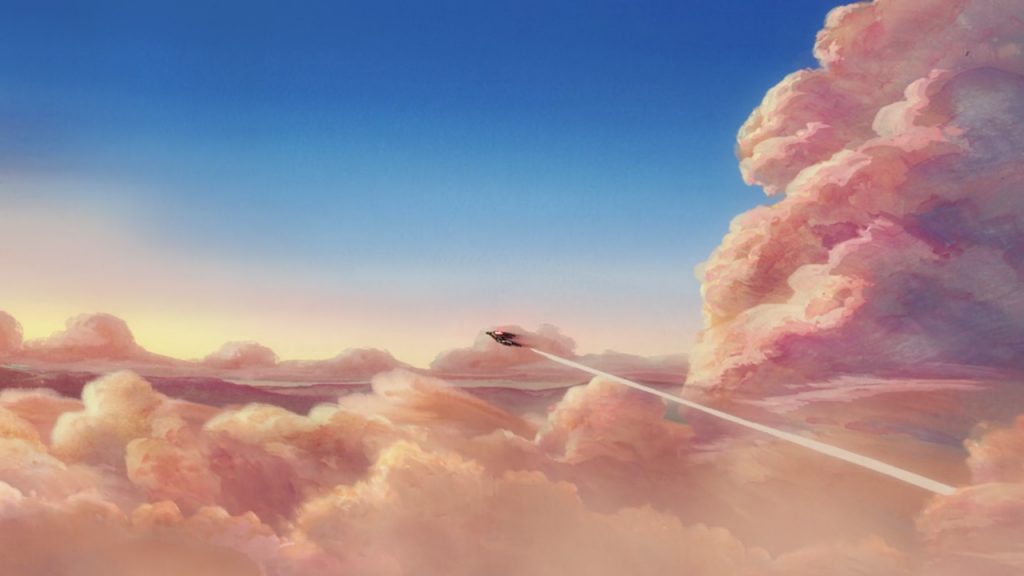
Dragon Pilot: Hisone & Masotan Production Notes 01
We couldn’t miss the opportunity to dig into this original, in all senses of the work, new TV series. We knew Hisone & Masotan was supported by an outrageous lineup of creators, but did the premiere live up to the pedigree of the staff? Time to analyze their work so far!
Episode 1
StoryboardStoryboard (絵コンテ, ekonte): The blueprints of animation. A series of usually simple drawings serving as anime's visual script, drawn on special sheets with fields for the animation cut number, notes for the staff and the matching lines of dialogue.: Hiroshi Kobayashi
Episode DirectionEpisode Direction (演出, enshutsu): A creative but also coordinative task, as it entails supervising the many departments and artists involved in the production of an episode – approving animation layouts alongside the Animation Director, overseeing the work of the photography team, the art department, CG staff... The role also exists in movies, refering to the individuals similarly in charge of segments of the film.: Shohei Miyake
Chief Animation DirectionAnimation Direction (作画監督, sakuga kantoku): The artists supervising the quality and consistency of the animation itself. They might correct cuts that deviate from the designs too much if they see it fit, but their job is mostly to ensure the motion is up to par while not looking too rough. Plenty of specialized Animation Direction roles exist – mecha, effects, creatures, all focused in one particular recurring element.: Yoshiyuki Ito
Animation DirectionAnimation Direction (作画監督, sakuga kantoku): The artists supervising the quality and consistency of the animation itself. They might correct cuts that deviate from the designs too much if they see it fit, but their job is mostly to ensure the motion is up to par while not looking too rough. Plenty of specialized Animation Direction roles exist – mecha, effects, creatures, all focused in one particular recurring element.: Koichi Horikawa, Eiichi Akiyama, Asame Gishin, Kaori Saito, Ikko Inaguma, Nayumi Okashiwa
Mecha Animation DirectionAnimation Direction (作画監督, sakuga kantoku): The artists supervising the quality and consistency of the animation itself. They might correct cuts that deviate from the designs too much if they see it fit, but their job is mostly to ensure the motion is up to par while not looking too rough. Plenty of specialized Animation Direction roles exist – mecha, effects, creatures, all focused in one particular recurring element.: Keiichiro Honjo
Key AnimationKey Animation (原画, genga): These artists draw the pivotal moments within the animation, basically defining the motion without actually completing the cut. The anime industry is known for allowing these individual artists lots of room to express their own style.: Koichi Horikawa, Eiichi Akiyama, Keiichiro Honjo, Kenji Mizuhata, Satoshi Ishino, Yushi Tanaka, Nayumi Okashiwa, Kazuki Kuramoto, Chiyo Nakayama, Yuichi Fujimaki, Shuhei Nishitani, Katsuo, Takashi Wabe, Naho Kiyoike, Kana Miyai, Yasushi Tokuda, Ryoun Tsuchiya, Yasunori Matsuki, Kaori Higuchi, Arisa Hoshina, Naoto Abe
─ Our main focus in the season preview was introducing the exceptional key creative staff behind the series, but the time has come to examine the work of all those high-profile names on a technical but also thematic sense. Everyone’s input will be supervised by outstanding series directorSeries Director: (監督, kantoku): The person in charge of the entire production, both as a creative decision-maker and final supervisor. They outrank the rest of the staff and ultimately have the last word. Series with different levels of directors do exist however – Chief Director, Assistant Director, Series Episode Director, all sorts of non-standard roles. The hierarchy in those instances is a case by case scenario. Hiroshi Kobayashi, who as tends to be the norm in this industry, also storyboarded the premiere. A clear point of focus in his work here was on protagonist Hisone’s journey from a highschool graduate to her new occupation of dragon pilot. It’s no coincidence that she was present in almost every scene! Her struggle to find a suitable place in life to match her outspokenness is shown through her reflective self-isolation, and it’s through ideas like this where can see just how well Kobayashi’s boards complement Mari Okada‘s energetic script. In contrast to Kobayashi’s seasoned sensibilities, episode director Shohei Miyake is a relative newbie in the field; his only hands-on experience was directing flashback sequences and co-directing episodes 9 and 12 of A.I.C.O. Incarnation, where he was also credited as series director’s assistant. He’s a former production assistantProduction Assistant (制作進行, Seisaku Shinkou): Effectively the lowest ranking 'producer' role, and yet an essential cog in the system. They check and carry around the materials, and contact the dozens upon dozens of artists required to get an episode finished. Usually handling multiple episodes of the shows they're involved with. who appears to have some motivation to become a series directorSeries Director: (監督, kantoku): The person in charge of the entire production, both as a creative decision-maker and final supervisor. They outrank the rest of the staff and ultimately have the last word. Series with different levels of directors do exist however – Chief Director, Assistant Director, Series Episode Director, all sorts of non-standard roles. The hierarchy in those instances is a case by case scenario., so I’m curious what the future has in store for him.
─ The show is being animated at BONES Sub-studio A, led by animation producer Naoki Amano. Consequently, there’s a rather big animation staff overlap with A.I.C.O. as HisoMaso’s production started shortly after the former wrapped up. It’s quite the contrast seeing HisoMaso‘s simplistic animation designs in comparison with A.I.C.O.‘s troublesome linecount, but I believe that serves as a relief for the animators in charge. Just compare the animation corrections shown at BONES’ Anime Japan booth; a simple glance tells us that, despite being handled by similar crews, the aesthetic of both shows is very different on a fundamental basis. If you’re curious as to why there’s so many animation directors listed on episode one, I have to admit that I was considerably surprised as well. It’s too soon to deduce any concrete answers from it, but my hunch tells me it’s more a case of this being the show’s specific approach to production as opposed to evidence of a rushed schedule, mainly because the episode looked very polished and there haven’t been behind the scenes complaints about the situation. Only time will tell us for sure, though.
─ While the animation was on the lively side, it’s not the kind of abundant showcase of movement or nuance that merits a recommendation to those who want a so called sakugaSakuga (作画): Technically drawing pictures but more specifically animation. Western fans have long since appropriated the word to refer to instances of particularly good animation, in the same way that a subset of Japanese fans do. Pretty integral to our sites' brand. anime. Nonetheless, the designs give animators a lot of room to breathe, and that shows especially in the facial expressions and freedom of movement. Hisone’s first encounter with Nao could be used as a prime example of what I’m referring to. Another good example is this brief yet expressive sequence between the two titular characters, animated by a member of the Uguiso Kobo circle, likely Yushi Tanaka. Character designer and chief animation directorChief Animation Director (総作画監督, Sou Sakuga Kantoku): Often an overall credit that tends to be in the hands of the character designer, though as of late messy projects with multiple Chief ADs have increased in number; moreso than the regular animation directors, their job is to ensure the characters look like they're supposed to. Consistency is their goal, which they will enforce as much as they want (and can). Yoshiyuki Ito said in an interview that Nao is popular with animators, female ones in particular, so expect lots of character animation highlights revolving around her. The most spectacular moment however was Hisone and Masotan’s first flight, presumably animated by mecha animation director Keiichiro Honjo and BONES animator Kenji Mizuhata. It’s such a magical moment made all the better by each and every production department pouring everything they have into it.
─ Art directorArt Director (美術監督, bijutsu kantoku): The person in charge of the background art for the series. They draw many artboards that once approved by the series director serve as reference for the backgrounds throughout the series. Coordination within the art department is a must – setting and color designers must work together to craft a coherent world. Yuji Kaneko and his studio Aoshashin left me stunned with their traditionally painted background art, which manages to look very different to their previous works despite the recurring quirks. The use of dark outlines are perhaps what make the most significant difference overall; Kaneko has been sharing background art paintings on his twitter account since the show premiered, and even gave fans a peek at what the backgrounds looked like during the development stages. This made it apparent that they originally looked very similar to his work on Kill la Kill and especially Little Witch Academia before they decided to implement the dark outlines. The results are as fantastic as ever, and as much as I enjoy his previous work, I can’t deny that it feels refreshing to see a new take on his usual style.

─ To match the traditionally painted backgrounds and make the characters fit in, BONES’ compositing department strengthened the lines drawn by animators during the post-processing. Heavy line post-processing has become a gradually growing trend in the industry ever since Graphinica’s Yoshihiro Sekiya started applying it to his works (Occultic;Nine, Granblue Fantasy). There have been instances when this procedure was misused or the result was far from satisfactory, but I’d say the team at BONES nailed it with this show. One delightful little detail is that this effect was even applied to the CG models, which helps in making them feel at home with other visual elements. Huge props to CG director Yota Ando, whose work always blends in well with the surrounding 2D elements. BONES’ shows don’t have the most ambitious CG usage, but when they have to rely on it, it hardly ever looks jarring.
BONES 最高
Support us on Patreon to help us reach our new goal to sustain the animation archive at Sakugabooru, SakugaSakuga (作画): Technically drawing pictures but more specifically animation. Western fans have long since appropriated the word to refer to instances of particularly good animation, in the same way that a subset of Japanese fans do. Pretty integral to our sites' brand. Video on Youtube, as well as this SakugaSakuga (作画): Technically drawing pictures but more specifically animation. Western fans have long since appropriated the word to refer to instances of particularly good animation, in the same way that a subset of Japanese fans do. Pretty integral to our sites' brand. Blog. Thanks to everyone who’s helped out so far!
Interesting, I did not notice the line post-processing at all, which I guess means it’s been done properly. In last season’s Hakumei to Mikochi it was unfortunately very noticeable. Couldn’t they achieve the same effect by reducing cleanup somehow?